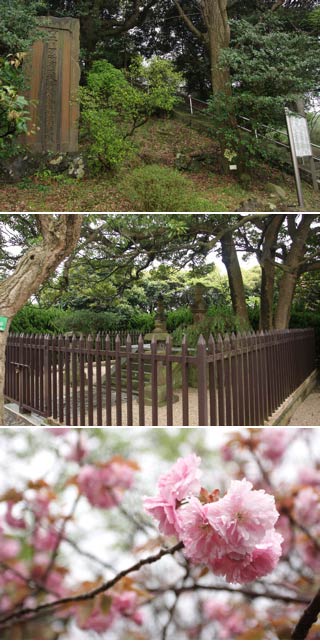William Adams (September 24, 1564 – May 16, 1620), also known in Japanese as Anjin-sama (anjin, "pilot"; sama, a Japanese honorific, corresponding to Lord/Excellency) and Miura Anjin (三浦按針: "the pilot of Miura"), was an English navigator who travelled to Japan and is believed to be the first Briton ever to reach that country. He was the inspiration for the character of John Blackthorne in James Clavell's bestselling novel Shōgun.
Soon after Adams' arrival in Japan, he became a key advisor to the shogun Tokugawa Ieyasu and built for him Japan's first Western-style ships. Adams was later the key player in the establishment of trading factories by the Netherlands and England. He was also highly involved in Japan's Red Seal Asian trade, chartering and captaining several ships to Southeast Asia. He died in Japan at age 55, and has been recognized as one of the most influential foreigners in Japan during this period.
Permanent Preservation of Historical Relics
In 1966, Yokosuka City established the Association of preservation of Tsukayama-Park in order to permanently preserved the graves of William Adams, Japanese Name "MIURA ANJIN" and his wife.
The first white samurai
William Adams is often known as the first foreign samurai. However, he may have been preceded by an African, Yasuke, who served Oda Nobunaga, some twenty years prior to Adams' arrival. It is also likely that some Korean or Chinese might have served a Daimyo during Sengoku period.
The shogun took a liking to Adams and made him a revered diplomatic and trade advisor and bestowed great privileges upon him. Ultimately, Adams became his personal advisor on all things related to Western powers and civilization and, after a few years, Adams replaced the Jesuit Padre João Rodrigues as the Shogun's official interpreter. Padre Valentim Carvalho wrote: "After he had learned the language, he had access to Ieyasu and entered the palace at any time"; he also described him as "a great engineer and mathematician".
1707 map of Japan, with a cartouche representing the audience of William Adams with the Shogun. From Naaukeurige Versameling der Gedenk-Waardigste Zee en Land-Reysen (a series of accounts of famous land- and sea-voyages). Thought to be by Pieter van der Aa.
Adams had a wife and children in England but Ieyasu had forbidden the Englishman to leave Japan. He was presented with two swords representing the authority of a Samurai. The Shogun decreed that William Adams the pilot was dead and that Miura Anjin (三浦按針), a samurai, was born. This made Adams's wife in England in effect a widow (although Adams managed to send regular support payments to her after 1613 via the English and Dutch companies) and "freed" Adams to serve the Shogunate on a permanent basis. Adams also received the title of hatamoto (bannerman), a high-prestige position as a direct retainer in the Shogun's court.
He was provided with generous revenues: "For the services that I have done and do daily, being employed in the Emperor's service, the emperor has given me a living" (Letters). He was granted a fief in Hemi (Jpn: 逸見) within the boundaries of present-day Yokosuka City, "with eighty or ninety husbandmen, that be my slaves or servants" (Letters). His estate was valued at 250 koku (a measure of the yearly income of the land in rice, with one koku defined as the quantity of rice sufficient to feed one person for one year). He finally wrote "God hath provided for me after my great misery" (Letters) by which he meant the disaster-ridden voyage that had initially brought him to Japan.
Adams's estate was located next to the harbour of Uraga, the traditional point of entrance to Edo Bay, where he is recorded to have dealt with the cargoes of foreign ships. John Saris related that when he visited Edo in 1613, Adams was in possession of the reselling rights for the cargo of a Spanish ship at anchor in Uraga Bay.
Adams' position gave him the means to marry Oyuki (お雪), the daughter of Magome Kageyu, a highway official who was in charge of a packhorse exchange on one of the grand imperial roads that led out of Edo (roughly present day Tokyo). Although Magome was important, Oyuki was not of noble birth, nor high social standing, so it was likely that Adams married out of true affection rather than for social reasons. Adams and Oyuki had a son called Joseph and a daughter named Susanna. Adams however found it hard to rest his feet and was constantly on the road. Initially, it was in the vain attempt to organize an expedition in search of the Arctic passage that had eluded him previously.
Adams had a high regard for Japan, its people, and its civilization:
The people of this Land of Japan are good of nature, curteous above measure, and valiant in war: their justice is severely executed without any partiality upon transgressors of the law. They are governed in great civility. I mean, not a land better governed in the world by civil policy. The people be very superstitious in their religion, and are of diverse opinions. (William Adams's letter to Bantam, 1612)
(reference wikipedia)
The annual memorial ceremony is held every April and is recognized as one of the four magnificent international events in the city of Yokosuka. Please cherish these historical relics in honor of keeping good relationship between the people of the United Kingdom and Japan.






